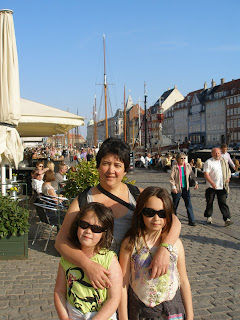Another bank holiday, it’s a long holiday weekend in Denmark
Despite being a bank holiday Morten Lauritzen of Jupiter Eel, Stege (about 50 miles south of Copenhagen
Anyway left the wife and kids to make their way into Copenhagen
I began to get seriously worried, I was still half an hour early but it seemed that nobody knew where this place was and I knew I had forgotten the phone number. I decided to drive around the complex again and round to the front entrance of a grand old building. On one of the doors I just happened to notice a faded black and white label, “Jupiter Al.” This is the eel farm I had been looking for! What really puzzled me is that this was about 250 yards from the petrol station and about 15 yards from the mini-market!!!!!!! Morten certainly has maintained his secrecy, despite being there for 25 years.
As I pulled into the parking space Morten was there to greet me and I reiterated how grateful I was for him to give up his time to see me on this bank holiday.
We proceeded into this huge red brick building, a network of chasms, which Morten rented to run his operation. The sugar factory was built in the late 1800’s and most of the original structure appeared unaltered. It was quite easy to picture the scene of the factory running at full pace 130 years ago….bedraggled and weary, factory workers toiling in impossibly hot and filthy conditions.
Anyway, it was not long before I heard the familiar sound of splashing water, bubbling air and that wonderful smell of fish food. No matter how many farms I go to….. I still love that combination.
Morten led me in to what looked like a ‘Great Hall’ in a medieval castle which housed the main on-growing tanks. There were 17 and they measured 5.3m X 5.3 m X 1m deep each holding 25,000 eels of approx 80g.
The tanks were totally covered, with just a small hatch for the feeder and to inspect condition. Morten said he never needed to clean them if he kept the water quality in tip top condition. Next we inspected his filtration set up. Two huge drum filters filtering down to 40 microns were supported by fluidised bio-filters, static bio-filters and Ultra violet sterilisation.
I had to marvel at the construction which was all Morten’s own design and one, which he had been at pains to point out, had been the result of many years of trial and error.
From here we ventured further into this industrial revolution ghost factory maze and saw many smaller juvenile tanks containing around 40,000 young eels. All looked in pristine condition.
I was lucky enough to handle a few individuals all tangled together on a resting platform.
All the time there were intermittent alarm sirens sounding and Morten and I would disappear into the depths of the building where he would interrogate the various water quality parameters on his computer system, never seeming too perturbed.
Finally, we came to the weaning room where there were many small tanks used for culturing the first stage of captured eel, the glass eel. These small tanks were full of small eels, approximately 30,000 in each tank which were just making the transition from cod roe to pellet food.
As we talked, I made furious notes jotting down all the things I knew I would forget when I returned to the UK
After a coffee and brief chat about stocking and breeding eels, I realised I had better let the man get back to his business. It was a thoroughly fascinating 2 hrs for me and as we shook hands and said goodbye, I felt sure that our paths would cross again in the not too distant future.
After a good drive back, I met the girls in time for tea at the city centre, nearby one of Hans Christian Anderson’s houses. We shared a couple of burgers and wedges and convinced ourselves that we were enjoying it. Sadly, still recovering from the food poisoning we were just glad to get back to the hotel and rest for the night.
After a good drive back, I met the girls in time for tea at the city centre, nearby one of Hans Christian Anderson’s houses. We shared a couple of burgers and wedges and convinced ourselves that we were enjoying it. Sadly, still recovering from the food poisoning we were just glad to get back to the hotel and rest for the night.






No comments:
Post a Comment